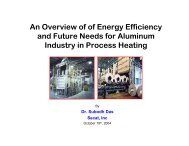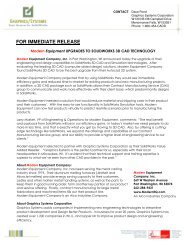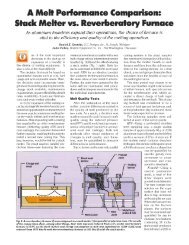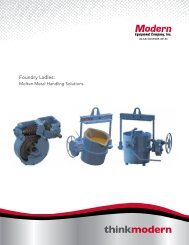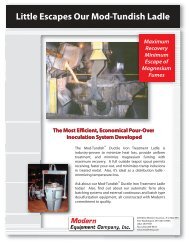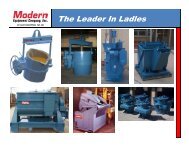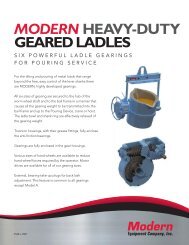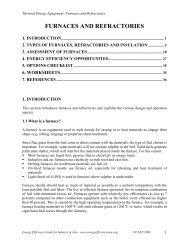ITP Metal Casting: Advanced Melting Technologies: Energy Saving ...
ITP Metal Casting: Advanced Melting Technologies: Energy Saving ...
ITP Metal Casting: Advanced Melting Technologies: Energy Saving ...
Create successful ePaper yourself
Turn your PDF publications into a flip-book with our unique Google optimized e-Paper software.
EBM is distinguished by its refining capacity. However, electron beam technology is primarily<br />
for melting refractory metals and laboratory-scale melts. One of the disadvantages of the electron<br />
beam process is its high capital cost due to its requirement of vacuum pumps. In addition, the fit<br />
up must be precise and locating the parts with respect to the beam must be perfect. 45 Therefore,<br />
the technology is not applicable in typical foundry operations.<br />
4.2.2 Immersion Heaters (High-Temperature <strong>Melting</strong>)<br />
Immersion heaters, although well established for melting zinc, is currently not well-adapted for<br />
melting metals with higher melting points. The protective ceramic coatings pose thermal barrier,<br />
lowering the melting efficiency. Several <strong>ITP</strong> <strong>Metal</strong> <strong>Casting</strong> projects are currently focusing on<br />
enabling this technology commercially.<br />
One <strong>ITP</strong>-sponsored project addresses the critical need for advanced materials that are lighter,<br />
stronger, and more corrosion-resistant than metals. 46 Work has been done to optimize the nitridebonded,<br />
silicon-carbide-fiber-reinforced Continuous Fiber Ceramic Composite (CFCC)<br />
immersion tube burners for application in aluminum and other light metal melting. The project<br />
validated that CFCC materials are stable in molten aluminum and in combustion gas for long<br />
periods. When tested at an industrial site, the immersion tube survived over 1,000 hours and 31<br />
cycles in an aluminum casting furnace. In another testing, the immersion tube successfully<br />
survived for 1,752 hours in the furnace.<br />
<strong>ITP</strong> has also been supporting research effort in the development of intermetallic alloys that<br />
possess improved or unique environmental resistance, which can result in efficiency benefits and<br />
energy savings. 47 Recently, researchers developed Ni3Al alloy that can withstand service<br />
temperatures of 100 to 150°C (180-270°F) higher than commercial Ni3Al alloys. Other alloys<br />
under study are based on the intermetallic alloy FeAl. These alloys can resist carburization and<br />
sulfidation that most commercial alloys cannot. In addition, alloys based on Ni3Si are being<br />
developed. The Ni3Si alloys have good mechanical properties and excellent resistance to<br />
oxidizing conditions, such as in sulfuric acid and seawater, and to ammonia at temperatures up to<br />
900°C (1,650°F). These kinds of intermetallic alloys can be applied in immersion heater tubes to<br />
withstand any wear from chemical reactions.<br />
An <strong>ITP</strong> cost-shared project called “Isothermal <strong>Melting</strong> (ITM)” shows promise for developing<br />
future models with in-plant thermal efficiencies of 97%. New materials and construction<br />
techniques allow immersion heaters to be built with high heat flux (approximately 70,000 Btu/hrft<br />
2 ) and external coatings that provide mechanical and chemical protection. These new heater<br />
designs are based on a highly conductive, impact- resistant ceramic coating on a metallic sheath<br />
and a highly thermally conductive, dielectric integral coupling medium between the sheath and<br />
the heat-producing element. This allows heat transfer by conduction to be the dominant mode,<br />
rather than particle-to-particle radiation heat transfer that prevails in conventional electric<br />
immersion heaters with compacted powder coupling media. The composite refractory coating is<br />
resistant to corrosive attack by the molten aluminum, yet sufficiently thin enough to provide a<br />
high heat flux. High flux heaters incorporated into the ITM are practical for large-scale<br />
applications. 48<br />
22



